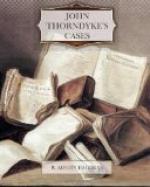“Useful stuff, this Fortafix,” he remarked; “it makes excellent casts, and saves the trouble and mess of mixing plaster, which is a consideration for small work like this. By the way, if you want to know what was on that poor girl’s pillow, just take a peep through the microscope. It is rather a pretty specimen.”
I stepped across, and applied my eye to the instrument. The specimen was, indeed, pretty in more than a technical sense. Mingled with crystalline grains of quartz, glassy spicules, and water-worn fragments of coral, were a number of lovely little shells, some of the texture of fine porcelain, others like blown Venetian glass.
[Illustration: THE SAND FROM THE MURDERED WOMAN’S PILLOW, MAGNIFIED 25 DIAMETERS.]
“These are Foraminifera!” I exclaimed.
“Yes.”
“Then it is not silver sand, after all?”
“Certainly not.”
“But what is it, then?”
Thorndyke smiled. “It is a message to us from the deep sea, Jervis; from the floor of the Eastern Mediterranean.”
“And can you read the message?”
“I think I can,” he replied, “but I shall know soon, I hope.”
I looked down the microscope again, and wondered what message these tiny shells had conveyed to my friend. Deep-sea sand on a dead woman’s pillow! What could be more incongruous? What possible connection could there be between this sordid crime in the east of London and the deep bed of the “tideless sea”?
Meanwhile Thorndyke squeezed out more cement on to the three little pieces of moulding-wax (which I suspected to be the objects that I had seen him wrapping up with such care in the hall of the Goldsteins’ house); then, laying one of them down on a glass slide, with its cemented side uppermost, he stood the other two upright on either side of it. Finally he squeezed out a fresh load of the thick cement, apparently to bind the three objects together, and carried the slide very carefully to a cupboard, where he deposited it, together with the envelope containing the sand and the slide from the stage of the microscope.
He was just locking the cupboard when a sharp rat-tat on our knocker sent him hurriedly to the door. A messenger-boy, standing on the threshold, held out a dirty envelope.
“Mr. Goldstein kept me a awful long time, sir,” said he; “I haven’t been a-loitering.”
Thorndyke took the envelope over to the gas-light, and, opening it, drew forth a sheet of paper, which he scanned quickly and almost eagerly; and, though his face remained as inscrutable as a mask of stone, I felt a conviction that the paper had told him something that he wished to know.
The boy having been sent on his way rejoicing, Thorndyke turned to the bookshelves, along which he ran his eye thoughtfully until it alighted on a shabbily-bound volume near one end. This he reached down, and as he laid it open on the table, I glanced at it, and was surprised to observe that it was a bi-lingual work, the opposite pages being apparently in Russian and Hebrew.




